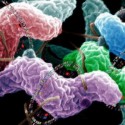
Enlarge Image |
Diagnosis: Usually specific laboratory tests identify the causative organism. Bacteria such as Campylobacter, Salmonella, E. coli O157 are found by culturing stool samples in the laboratory and identifying the bacteria that grow on the agar or other culture medium. Parasites, like Cyclospora, can be identified by examining stools under the microscope. Viruses are too small to see under the light microscope and are difficult to culture, so they are usually identified by testing stool samples for genetic markers that indicate a specific virus is present.
Constant Change: A century ago, typhoid fever, tuberculosis and cholera were common foodborne diseases. Improvements in food safety, such as pasteurization of milk, safe canning, and disinfection of water supplies have conquered those diseases. Today other foodborne infections have taken their place, including some that have only recently been discovered. For example, in 1996, the parasite Cyclospora suddenly appeared as a cause of diarrheal illness related to Guatemalan raspberries. These berries had just started to be grown commercially in Guatemala, and somehow became contaminated in the field there with this unusual parasite.
Cases: An estimated 76 million cases of foodborne disease occur each year in the United States. The great majority of these cases are mild and cause symptoms for only a day or two. Some cases are more serious, and CDC estimates that there are 325,000 hospitalizations and 5,000 deaths related to foodborne diseases each year.
Tracking: Public health departments routinely monitor important diseases in a program of disease surveillance and report to the Centers for Disease Control. Once an outbreak is strongly suspected, an investigation begins. Hypotheses about the likely sources for the disease are tested in a formal epidemiologic investigation.
Contamination: Many foodborne microbes are present in healthy animals (usually in their intestines) raised for food. Meat and poultry carcasses can become contaminated during slaughter by contact with small amounts of intestinal contents. Similarly, fresh fruits and vegetables can be contaminated if they are washed or irrigated with water that is contaminated with animal manure or human sewage. Later in food processing, other foodborne microbes can be introduced from infected humans who handle the food, or by cross contamination from some other raw agricultural product.
Bacterial Growth: Many bacterial microbes need to multiply to a larger number before enough are present in food to cause disease. Lightly contaminated food left out overnight can be highly infectious by the next day. In general, refrigeration or freezing prevents virtually all bacteria from growing but generally preserves them in a state of suspended animation. This general rule has a few surprising exceptions. Two foodborne bacteria, Listeria monocytogenes and Yersinia enterocolitica can actually grow at refrigerator temperatures. High salt, high sugar or high acid levels keep bacteria from growing, which is why salted meats, jam, and pickled vegetables are traditional preserved foods.
Cited: Multiple Campylobacter Genomes Sequenced